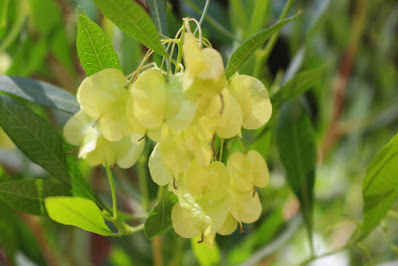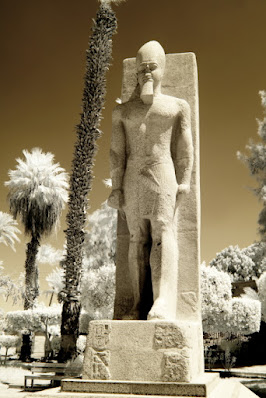The Akhnaton Carpets School in Giza Governorate, Egypt, is open to the public; but only limited photography is allowed. While we were on the tour, two sisters taught Sophia how to weave and they let her work on their carpet. We were going to have Sophia make each of us a carpet, but then we discovered that it takes an experienced carpet maker about six months to make a carpet. One man was working on a large carpet that was expected to take about 4 years to complete. Our tour guide said that when completed, the carpet would sell for about $10,000 US dollars. They also showed us a completed carpet and the pattern that had been used to make the design.
 |
| Picture by Kolohe |
 |
| Picture by Heather |
 |
| Picture by Kolohe |
The City of Memphis was founded in about 3100 B.C. and was the most important religious and commercial center in all of Egypt for 3,000 years. It was highly honored by the kings and was the place where they were traditionally crowned. Alexander the Great was originally buried in Memphis, but his body was later moved to Alexandria.
The name "Memphis" was derived from Men-nefer, meaning "Established and Beautiful," because the city was filled with palaces, gardens, and temples. However, during a Muslim invasion in the 7th century A.D., the City was abandoned. It is now part of the Cairo Metropolitan Area.
An exhibition building at the Mit Ahinah Museum in Memphis contains one of the two large 3,200-year-old statues of Ramses II that were each carved from single blocks of limestone. The other statue is in better condition and is located at a museum in Cairo.
Ramses II is considered to be the most famous King of Egypt and has been featured in several modern movies. He ruled over Egypt for 66 years and had over 100 children. (Not all from the same woman - he had a number of wives. Nefertiti was considered to be the Queen Wife.)
There are also a number of statues and other artifacts on the site that were found at different locations in the city. Rather than displaying things where they were found, the city is currently trying to consolidate many of the artifacts at this location.
 |
| Picture by Kolohe |
 |
| Picture by Kolohe |
 |
| Picture by Kolohe |
 |
| Picture by Kolohe |
The largest alabaster Sphinx statue ever found is displayed on the museum grounds. The statue weighs over eighty tons. It is believed that there are large amounts of artifacts that are still buried in Memphis and have never been discovered and unearthed.
After touring the site, we walked across the street for some refreshments - fresh fruit and mango drinks. I sat in the shade under some flowering plants sipping a mango drink and watched all of the traffic go by (or when it didn't go), while everyone else spent their time and money in the souvenir shop. Kolohe purchased an Egyptian ruler that contained the hieroglyphic alphabet for each child in her Las Vegas Kindergarten class.
 |
| Picture by Kolohe |
 |
| Picture by Heather |
 |
| Picture by Kolohe |
After feeling somewhat refreshed we visited Sultan's Flowers Extract Palace, where they sold various oils made from flowers. We were told that the oils could cure any health problem that you may be experiencing. Since I am allergic to many flowers, this was not my favorite stop, especially when they blew some type of vapor in everyone's face.
 |
| Picture by Kolohe |
 |
| Picture by Kolohe |
 |
| Picture by Kolohe |
 |
| Picture by Kolohe |
 |
| Picture by Kolohe |
 |
| Picture by Kolohe |
The Pyramids of Giza are the most visited and photographed Pyramids in all of Egypt because they are just across the Nile River from Cairo. To get there, many local people do not follow the road, they just drive across any vacant land that leads in the general direction. (Our van driver stayed on the road.)
 |
| Picture by Kolohe |
At the Giza location, the Pyramid of Khufu ("The Great Pyramid") is the largest pyramid, followed by the Pyramid of Khafre, which is slightly smaller, and then the Pyramid of Menkaure, which is smallest of the three.
 |
| Picture by Kolohe |
 |
| Picture by Khaled Using Kolohe's Camera. |
After visiting "The Great Pyramid," we decided to ride camels down to the Sphinx and explore some ruins along the way. I was surprised that ridding a camel was a lot different than ridding a horse. It is a much rougher ride with lots of jolts. Sophia was thrilled that she made it alive.
 |
| Picture by Camel Jockey using Heather's Camera |
 |
| Picture by Heather |
 |
| Picture by Camel Jockey on Kolohe's camera |
 |
| Picture by Kolohe |
When Sophia saw the Sphinx, she said it was love at first sight. I gave her some grandfatherly advice and told her that the Sphinx was too old for her and she needed to find someone younger that had a nose.

 |
| Picture by Heather |
 |
| Picture by Kolohe |
 |
| Picture by Kolohe |
 |
| Picture by Khaled on Heather's Camera |
At the Egyptian Scribe Papyrus Factory we learned how to make papyrus and, of course, we had the opportunity to purchase some Egyptian paintings on papyruses that were made in the factory.
 |
| Picture by Kolohe |
 |
| Picture by Heather |
 |
| Picture by Kolohe |
 |
| Picture by Kolohe |
They also had pictures with one set of images when the lights were on, and a different set of images that glowed in the dark when the lights were turned off.
In the evening we stopped by a local restaurant (Restaurant Abo Emad) for dinner. I do not know what we were eating, but it was quite tasty. While we were in Egypt, every time we went out to eat they always served us way too much food.
 |
| Picture by Kolohe |
 |
| Picture by Kolohe |
 |
| Picture by Kolohe |
 |
| Picture by Heather |
After the sun set, we could see the Giza Pyramid light show from our hotel balcony.
 |
| Picture by Heather |
 |
| Picture by Kolohe |
PICTURES BY KOLOHE










































































No comments:
Post a Comment